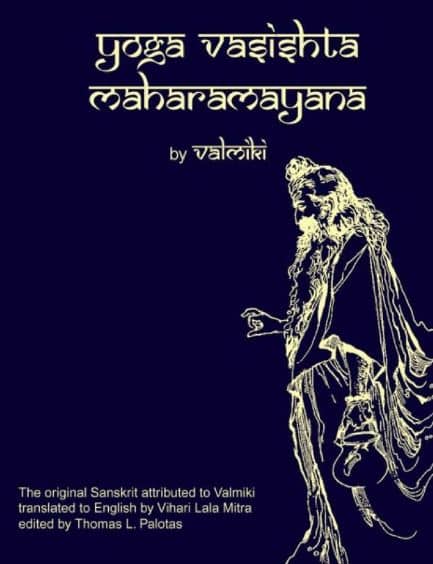‘Yoga Vasistha’ PDF Quick download link is given at the bottom of this article. You can see the PDF demo, size of the PDF, page numbers, and direct download Free PDF of ‘Yoga Vasistha Maharamayan’ using the download button.
Yoga Vasistha The Art Of Self Realization PDF Free Download

Yoga Vasistha Maharamayan
THE YOGA-VASISTHA is a popular text on Non-dual God, Ancient in form and philosophical in content it is also known by other names like Knowledge Vasistha,
Maha Ramayana, Vasistha Ramayana, and Vasistha are ascribed to Sage Valmiki himself.
It is in the form of replies given by Vasistha to Sri Rama’s queries regarding philosophical problems of life and death, and human suffering, and treats the essentials of Advaita Vedanta.
Yoga Vasistha, written by Sage Valmiki, is the spiritual teaching imparted by Sage Vasistha to Sri Rama.
Yoga Vasistha is also known as the Maha Ramayana, the Uttar Ramayana, and the Vasistha Ramayana It describes how Rama’s knowledge,
wisdom and understanding evolved and progressed throughout the different stages of his Yoga Vasistha is an elaborate work, consisting of 32,000 verses and 64,000 lines.
The main theme of Yoga Vasistha is that the soul is undergoing a dream from which it must awake. This dream represents our association and identification with the world.
The fact that it is described as being a dream means that whatever is in it has to be false. Nothing in a dream can be true.
Waking up from that dream is the ultimate goal, Self-realization. People who are interested in self-realization can also study the more comprehensive Brihat Yoga Vasistha book and the smaller one, Laghu Yoga Vasistha.
The term Brihat means great, while Laghu signifies small.
The total of pleasures of the whole world is a mere drop when compared to the bliss of Moksha When all the desires are destroyed, the extinction of the mind where Mind becomes “No-Mind” is Moksha.
If the illusory I-ness or Ego perishes, the end of thoughts to the Maya is Moksha. Extinction of all Psychological conditioning constitutes Eternal Liberation of the Self.
Self Knowledge is the realization that the Self is in reality not bound, but always pure and free.
Realize that you are the immortal all-pervading Self and become free. This is the goal of our life and the goal of our existence.
Prahlada. the Demon King Devotee of Vishnu — Prahlada, lord of demons, is the son of Hiranykashipu who was defeated in battle by Narasimha, the man-lion incarnation of Vishnu.
Vishnu is the lord of gods and the enemy of the demons. Prahlada becomes a devotee of Vishnu, as do his demons.
Through discrimination Prahlada attains enlightenment and performs tapas for thousands of years, throwing the demon world into anarchy for lack of a ruler.
Vishnu awakens Prahlada, explains living liberation, and Prahlada resumes his governing duties. (V.30-41)
Gadhi — Gadhi the Brahmin loses consciousness as he performs his ritual bathing.
He wakes up as a child in the womb of a tribal woman.
He lives a lifetime among tribals until he outlives his contemporaries, then wanders to a rich city, Kira.
There the royal elephant chooses him to be the successor king.
After eight years of rule, the citizens discover he is a tribal, so Brahmins and ministers immolate themselves in disgust.
Gadhi does the same, and as he throws himself on his funeral pyre, he wakes up and realizes that his entire life as a tribal and a king was a brief daydream But the dream seems so real that Gadhi travels to where he lived as a tribal and where he ruled as king.
Three times he explores, interviews witnesses, and thinks that it had all happened. Three times he does tapas to Lord Vishnu who tells him it was just in his mind.
Uddalaka — Uddalaka practices discrimination, meditates in samadhi, and practices pranayama breath control.
The story is an occasion to explain some aspects of pranayama.
King Suraghu — King Suraghu of the Kiratas (indigenous peoples of the Himalayan foothills) receives instruction from sage Mandavya, practices self-inquiry, and attains Self-realization.
King Parigha — King Parigha of Persia, disheartened by a severe famine, performs tapas and becomes known as Parnada (“Leaf-eater”).
He wanders about and meets his old friend, the now Selfrealized King Suraghu of the Kiratas and they discuss enlightenment.
Bhasa and Vilasa — The two friends grow up in the ashram of sage Atri, then wander off to perform severe austerities but without gaining true knowledge.
They meet again as old hermits, converse, and finally attain liberation. (V.65-66)
Vitahavya — Vitahavya abandons his practice of puja and yagna (ritual worship and fire sacrifices) and practices self-inquiry He attains samadhi and performs tapas in a cave for such a long time that his body becomes inert and is covered in deep mud and clay.
The sage devotionally bids farewell to the various aspects of his body and attains liberation
Read: Yoga Vashistha In Hindi, Yoga Vashistha In Marathi
| Author | Valmiki |
| Language | English |
| Pages | 1845 |
| PDF Size | 8.2 MB |
| Category | Spiritual |
Related PDFs
Yoga Vasistha Maharamayan: The Art of Self Realization PDF Free Download
